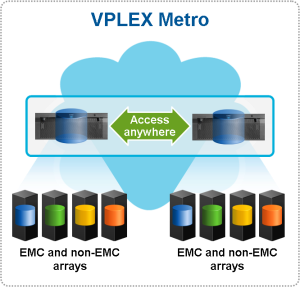In March, Pat Gelsinger introduced EMC’s vision for Virtual Storage (my blog post is here). Today, EMC announced the VPLEX family of products—the first new products that deliver on the vision. VPLEX is a Distributed Federation solution, which means that we can enable a single copy of data to be shared, accessed and relocated over distance. When new technologies are introduced into the marketplace, people are most comfortable in making comparisons to things that they already know. In this post, I’ll compare traditional replication solutions with VPLEX Distributed Federation.
Federation Instead of Separation
In a traditional replication solution, there is a primary site and a secondary site for failover or recovery of data. In contrast, with VPLEX, the data is active at both sites at the same time.  Rather than putting together complex failover scenarios, having the flexibility to have active data between sites will allow for maintenance without downtime and workload balancing across multiple data sites. Instead of thinking of “site A” and “site B” separated by policies and distance, we can start to think of our pool of federated resources that spans multiple physical data centers. VPLEX can change how you think about deploying data centers; rather than a disaster recovery site, deploy data centers to achieve additional efficiencies (such as taking advantage of low cost energy) and performance (optimizing locations to be close to clients).
Rather than putting together complex failover scenarios, having the flexibility to have active data between sites will allow for maintenance without downtime and workload balancing across multiple data sites. Instead of thinking of “site A” and “site B” separated by policies and distance, we can start to think of our pool of federated resources that spans multiple physical data centers. VPLEX can change how you think about deploying data centers; rather than a disaster recovery site, deploy data centers to achieve additional efficiencies (such as taking advantage of low cost energy) and performance (optimizing locations to be close to clients).
Near Today, Far Tomorrow
The network between the locations is critical for any solution to work. Similar to replication solutions, we can consider whether a solution is synchronous or asynchronous and how the network fits into a customer’s existing environment. Enterprise customers will typically have network connectivity between locations that are close to each other. When these existing links have the appropriate bandwidth and other network characteristics–such as those required for replication solutions–the same links can also be used for VPLEX. Synchronous solutions of 100km are available with VPLEX Metro today. Longer distance (asynchronous) solutions require special links. Asynchronous solutions will be available with VPLEX Geo in 2011.
As I hinted at in my previous post, the VPLEX solution ties into other development work from partners. VPLEX will expand the solutions of VMware VMotion (see this great VPLEX/VMotion whitepaper) and Microsoft Live Migration, plus work with the latest networking technologies from Cisco (including leveraging OTV) and Brocade. Virtualization of your servers, network and storage redefines the boundaries of the Data Center by creating a single pool or resources separated by distance.
_________________________________________________________
Click on the graphic above to go to the VPLEX launch site which includes customer videos and whitepapers. You can also hear more about VPLEX live on May 10th with streaming internet TV from EMC World: Pat Gelsinger at will be on at 3pm Eastern and Brian Gallagher at 4pm Eastern.
Stuart Miniman





 Posted by Stuart Miniman
Posted by Stuart Miniman 

